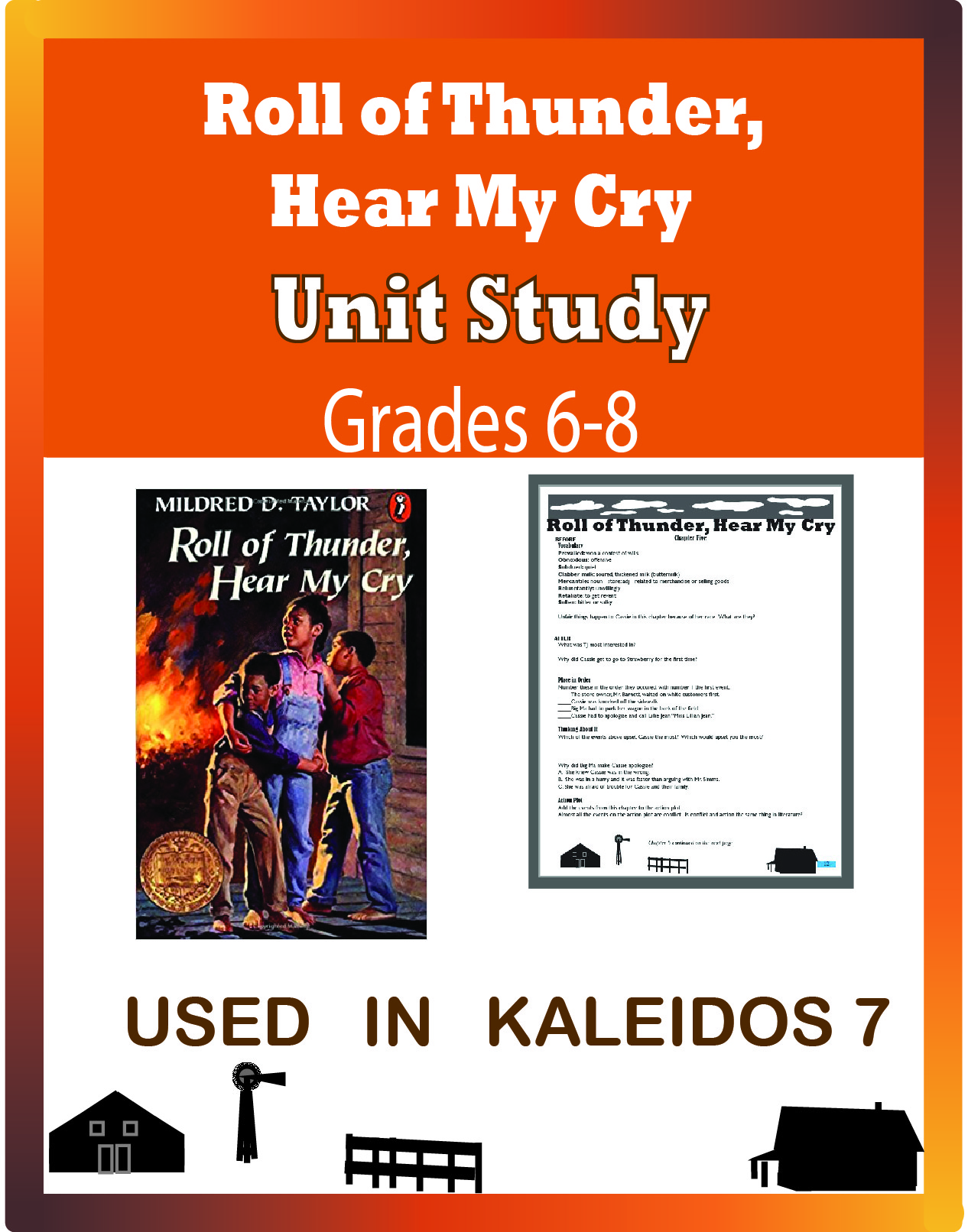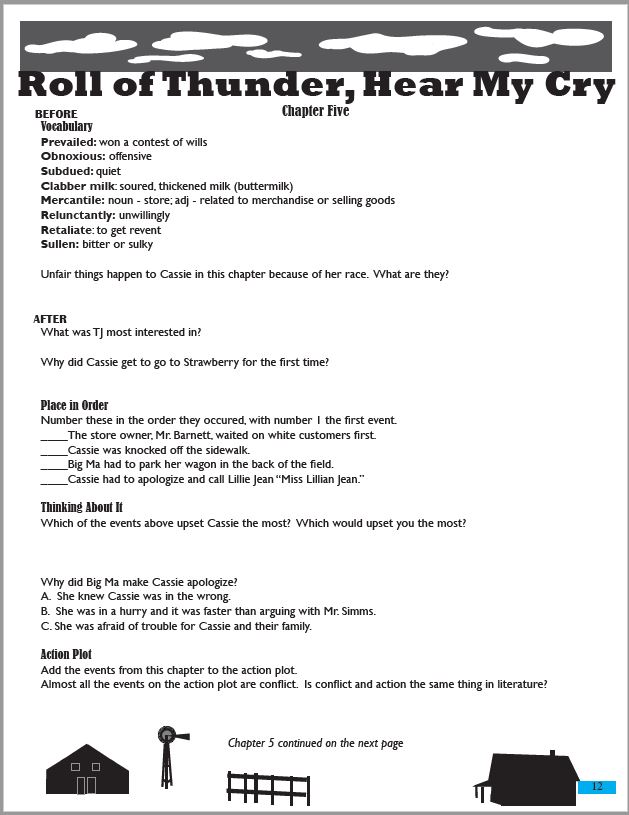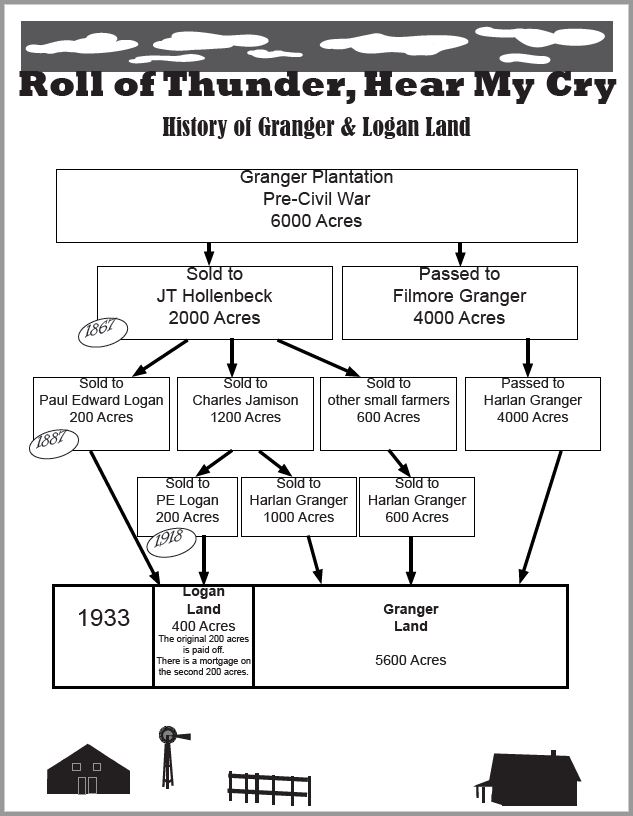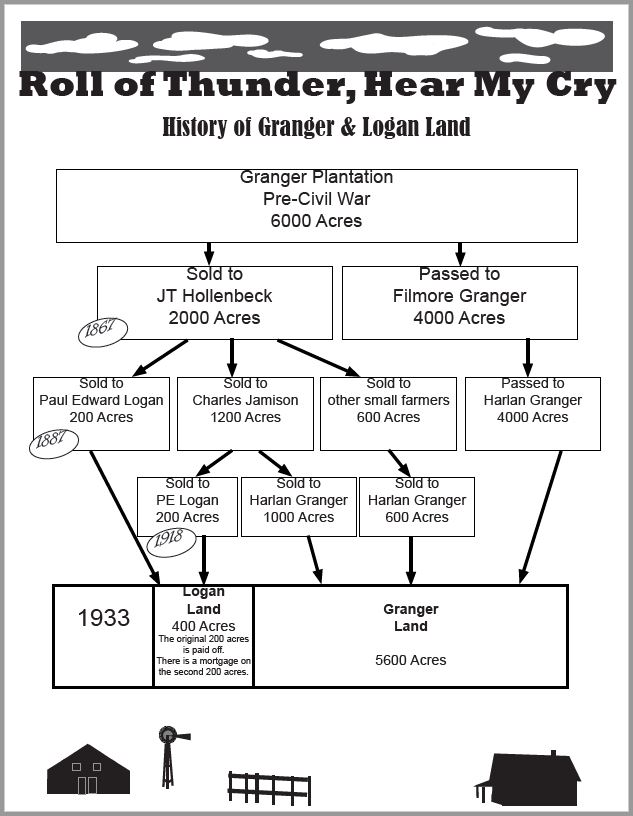
Roll of Thunder Unit Study
Roll of Thunder Unit Study guides students in 6th - 9th grade with activities correlated to Roll of Thunder, Hear My Cry, by Mildred Taylor.

Roll of Thunder Summary

Whispered conversations of night riders and burnings are over-heard at home. But the threat of losing their farm land is one of the family's greatest worries, as her grandmother tells the story of how the land was purchased, but the town tycoon wants to force them to give it up so he can own all the land of his ancestors' pre-Civil War plantation.
When Mama is fired from her job teaching at the black school, and the mortgage note on their property is called for full payment before time, it looks like they will lose their land.
Her brother's former friend, TJ, has been getting into trouble. He is set up for a robbery and murder, and a mob comes to his house to lynch him. With the long brewing storm coming and the crashing of thunder and lightening, Cassie runs as fast as she can to her father for help, knowing the mob wants to lynch him too. Will Papa be able to stop the lynching? Is there any hope for their land?
Roll of Thunder Unit Study Guide


Student Guide AND Teacher's Answer Key Included
$2.99 Download - 50 pages
![]()
What is in The Unit Study Guide?

Chapter by Chapter Activities
The twelve chapters in this book all have corresponding activities in the Roll of Thunder Unit Study. Vocabulary words are listed at the beginning of the chapter. Discussion and reading comprehension questions are included with every chapter. In addition, the other activities listed below are included with the appropriate chapter.Literary Elements
Students investigate how authors make a story come to life with literary elements. Activities include:- Develop a character list
- Make a collage of the setting
- Track the conflict and action through the chapters
- Make a character analysis venn diagram
- Identify the climax and denouement
- Compare first person and third person narratives
- Compare round and flat characters
- Analyze and imitate sentences with sensory images
Historical Context
Historical information is given at relevent locations in the book. Information is provided on:- Sharecropping
- Company stores
- Buying on credit
- Lynchings
- Negro Spirituals
Action, Action
Students can make their study of Roll of Thunder more lively with suggestions for:- Listening to music and poetry relevent to certain chapters
- Write a perform a skit about the credit and interest charged at company stores
- Cook some southern food like Cassie's family brought to the annual revival
Chart of the Logan Land

Sample Roll of Thunder Lesson Plans for Chapter One

Vocabulary
- Emanciated: extremely thin, usually from hunger or disease
- Sharecropper: farmers who live on and work land that does not belong to them. They have to give the owner part of the crops (usually half) in payment for being allowed to live on the land.
- Tidbit: small piece of an object or small piece of news
- Morosely: gloomily
- Amiably: friendly
- Ferociously: wildly or savagely
- Dubious: uncertain but probably not good
- Temerity: boldness or recklessness
- Maverick: a loner who does not run with or behave like the rest of a group
Setting: Make A Collage
The setting is extremely important in this story (as it is in all novels.) The setting includes time and place. Pay close attention to setting as the author introduces it in the first few pages. One way to showcase the setting of a book you read is to make a collage. The artwork on the top and bottom of this page provide some clues. Page 3 is blank for you to write information about the setting as it develops. You might like to use different colors and pictures to represent the setting or simply use words.Character List
You will meet an interesting cast of characters in this story. On page four, we have started a character list for you. Jot a few notes down about each one listed. Those names that come after the line will be introduced after chapter one. You do not need complete sentences for these notes.Point of View Review
Stories usually have one of the three common points of view:- 1st person: told by a narrator - usually (but not always) the main character
- 3rd person limited: no narrator, but the reader follows the limited perspective of one character who does not know everything. The reader often understands the thoughts and emotions of the main character or a limited number of characters.
- 3rd person omniscient: The reader has the advantage of knowing what all characters are doing and thinking.
Literary Analysis
The elements listed above (setting, characters, point of view, conflict) are major components of literature. Notice how authors scatter the information about setting and characters in the first chapters of a book. They are like treasures the reader discovers. You will continue to build your information about Setting, Characters, and Conflict as the book progresses. Most of the setting is already established by the end of Chapter One.Similies
Which phrases listed below from this chapter are similies? Similies use “as” or “like” to make comparisons.- sun-splotched road wound like a lazy serpent
- bus bore down on him spewing clouds of red dust like a huge yellow dragon breathing fire
- the last puff of cotton had been gleaned from the fields
Discussion Questions
- What sacrifices did the Logans make to keep their land?
- Compare the white and black schools as described in this chapter.
Hyperbole
Hyperbole is an exageration to make a point. The statement, “I have told you a million times,” is hyperbole.The author uses hyperbole to indicate the information on the inside of the school books. While schools did list the year, name of student, and condition on the inside of the books, they did not list race.
Why did the author do this? It is a form of hyperbole. She stated that the black schools did not get the books until they were old and the white school was ready to get new books. Everyone might agree that this was not fair; but many might not recognize how humiliating it was to have the school district demonstrate they did not value some of their students as much as others. This point is communicated more effectively by having the race listed as “nigra” in the front of a dilapidated book.
While the chart on the inside of the book might not be as historically accurate, it is more emotionally effective in showing the reaction of Little Man and Cassie. Can you think of other instances when authors have used hyperbole to communicate a point? What are the advantages and disadvantages of using hyperbole in historical fiction?

Buy the Roll of Thunder Unit Study Guide


Student Guide AND Teacher's Answer Key Included
$2.99 Download - 50 pages
![]()















